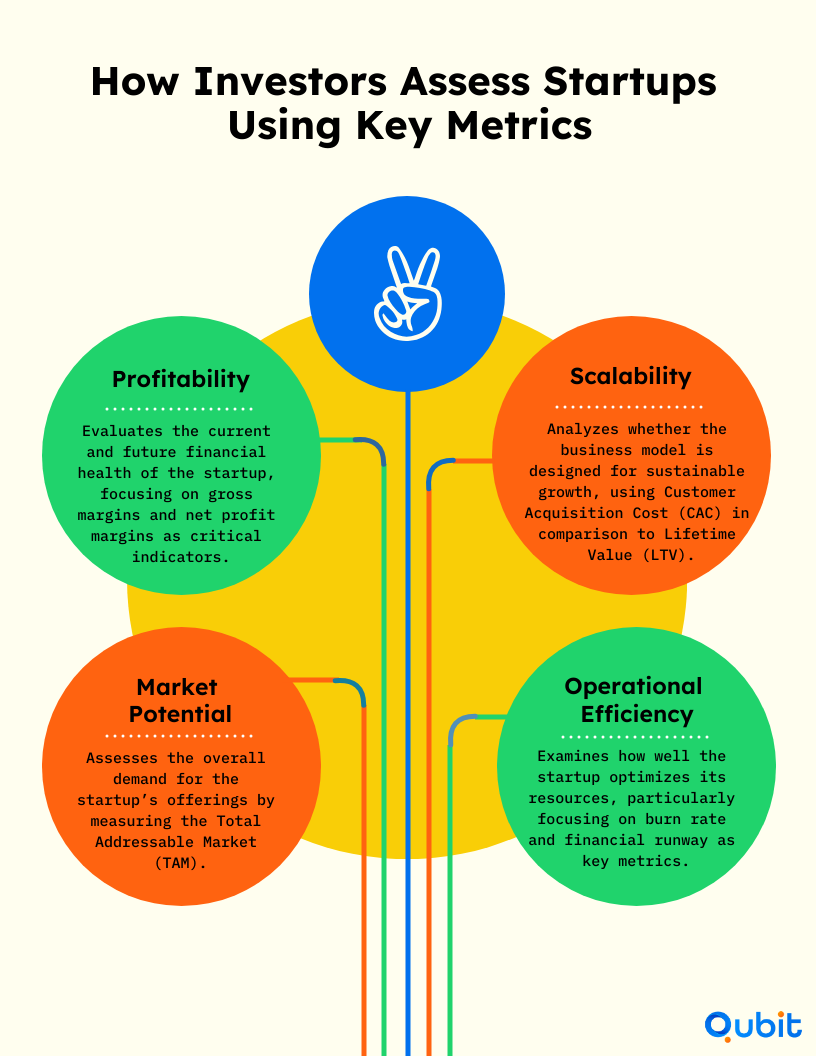Securing investment requires more than an innovative idea or a dedicated team. Investors receive countless pitches, so your startup must stand out with solid, tangible data.
Knowing which metrics startup investors prioritize can showcase your business's viability and attract the funding you need to grow.
But which startup metrics truly capture investors' attention? How can you present them effectively to both inform and persuade?
This guide explores the key performance indicators for startups that demonstrate success and scalability. We'll simplify complex concepts, provide practical calculations, and offer strategies to communicate your metrics compellingly.
Mastering these startup KPIs enhances your fundraising prospects and offers valuable insights into your company's health and trajectory. For an in-depth analysis, explore our Fundraising Metrics to Attract Investors, and learn how to deliver what investors are looking for with confidence.
Why Investors Care About Your Metrics
Investors rely on concrete data to make informed decisions. While passion and vision are valuable, it's the hard numbers that ultimately influence their choices.
Metrics for startups serve as quantifiable indicators of your company's performance, potential, and profitability.
How Investors Use Metrics to Evaluate Startups

Investors assess several aspects through your metrics:
- Profitability: Is your startup financially viable now and in the future?
- Scalability: Can your business model grow sustainably?
- Market Potential: Is there significant demand for your product or service?
- Operational Efficiency: How effectively are you utilizing resources?
By providing clear metrics, you speak the investor's language. It allows you to facilitate better communication which aligns with investor expectations.
Inside Investor Psychology: What Drives Their Decisions
Beyond the numbers, understanding investor psychology is fundamental. Investors interpret data to predict your startup's future. Their decisions are influenced by emotions, biases, and individual preferences.
Some investors prioritize rapid growth and market disruption, while others focus on steady profitability and sustainable practices. Recognizing these priorities allows you to tailor your presentation to resonate with them.
Learn how to prove your startup's potential through effective traction showcasing. By aligning your metrics with what investors value, you enhance your ability to connect and persuade.
Financial Metrics Investors Want to See
Financial metrics provide a snapshot of your startup's fiscal health and potential profitability. They're often the first indicators investors examine to assess your viability.
Total Addressable Market (TAM): Showcasing Your Startup's Potential
Understanding TAM and Its Importance
The Total Addressable Market (TAM) represents the total revenue opportunity available for your product or service if you achieve 100% market share. Demonstrating a substantial TAM shows investors the potential scale of your business.
A sizable TAM answers:
- Is the market large enough to support significant growth?
- Are there opportunities for market expansion?
- How does your offering fit within the broader market?
Calculating TAM
You can calculate TAM using two primary approaches:
- Top-Down Approach:
- Start with total market size from industry research.
- Narrow down based on relevant market segments.
- Example: If the global software market is $500 billion, and you're in the project management segment worth $50 billion, your TAM is $50 billion.
- Bottom-Up Approach:
- Begin with your product's price.
- Estimate the number of potential customers.
- Formula: TAM = Number of Potential Customers × Average Revenue Per Customer
Example: With 10,000 potential customers willing to pay $1,000 annually, your TAM is $10 million.
Advanced Insights
- Segment the Market Effectively:
- Identify Sub-Segments: Target specific customer groups for precision.
- Assess Competitiveness: Determine where you can compete most effectively.
- Calculating TAM in Emerging Markets:
- Account for volatility and growth projections.
- Use localized data and consider cultural factors.
Practical Strategies
- Tools for Accurate Estimation:
- Utilize industry reports from sources like Gartner or IBISWorld.
- Leverage data analytics platforms for market insights.
- Industry-Specific Examples:
- Healthcare Tech Startup: Calculate TAM based on potential virtual consultations times average fees.
- Eco-Friendly Products: Estimate the number of environmentally conscious consumers times their average spend.
For more on market analysis, read our guide on Market Sizing Techniques.
Revenue Growth Rate: Demonstrating Momentum
Why Consistent Growth Matters
Consistent revenue growth reflects business momentum and market acceptance.
Investors look for startups that not only generate revenue but also show a positive trajectory over time. It indicates your ability to scale and effectively penetrate the market.
How to Calculate Revenue Growth Rate
Formula:
Revenue Growth Rate = [(Current Period Revenue - Previous Period Revenue) / Previous Period Revenue] × 100%
Example:
- Previous Quarter Revenue: $200,000
- Current Quarter Revenue: $250,000
- Growth Rate: [(250,000 - 200,000) / 200,000] × 100% = 25%
Provide quarterly or annual calculations to help investors identify trends.
Advanced Insights
- Linear vs. Exponential Growth:
- Linear Growth: Steady increases; may suggest a saturated market.
- Exponential Growth: Rapid increases; indicates high demand and effective scaling.
- Sustainability of Growth:
- Is growth driven by sustainable factors?
- Consider customer acquisition strategies and market conditions.
Sample Example
Startup Alpha achieved 200% year-over-year revenue growth by:
- Expanding into new markets.
- Implementing aggressive marketing strategies.
- Enhancing products based on customer feedback.
Investors saw this as a sign of strong market demand and scalability.
Explore more on Strategies to Accelerate Revenue Growth.
Gross Margin and Operating Margin: Measuring Efficiency
What They Are and Why They Matter
- Gross Margin:
- Indicates how efficiently you produce goods or services.
- Formula: (Revenue - Cost of Goods Sold) / Revenue × 100%
- Operating Margin:
- Shows overall operational efficiency.
- Formula: Operating Income / Revenue × 100%
High margins suggest a strong business model and room for growth.
How to Calculate Margins
Example:
- Revenue: $500,000
- COGS: $200,000
- Operating Expenses: $150,000
- Operating Income: Revenue - COGS - Operating Expenses = $150,000
- Gross Margin: ($500,000 - $200,000) / $500,000 × 100% = 60%
- Operating Margin: $150,000 / $500,000 × 100% = 30%
Practical Strategies
- Optimize Costs:
- Streamline supply chains.
- Negotiate better terms with suppliers.
- Automate processes to reduce costs.
- Improve Profitability:
- Adjust pricing to reflect value.
- Diversify product lines.
- Focus on high-margin offerings.
Learn more about Optimizing Margins for Profitability.
Unit Economics: Understanding Profitability Per Unit
Assessing profitability at a per-unit level helps evaluate sustainability and scalability.
Key Components:
- Revenue Per Unit: Income generated from each sale.
- Cost Per Unit: Total cost of producing and selling each unit.
- Contribution Margin: Revenue per unit minus variable costs per unit.
For an in-depth analysis, explore Mastering Unit Economics.
Burn Rate and Runway: Managing Your Cash Flow
What They Mean
- Burn Rate: How quickly you're spending capital before generating positive cash flow.
- Runway: How long you can operate at your current burn rate before running out of cash.
Formula:
Runway = Cash Reserves / Monthly Burn Rate
Strategies for Cash Management
- Reduce unnecessary expenses.
- Increase revenue streams to lower burn rate.
- Plan fundraising before your runway ends.
Learn how to manage your cash flow by Calculating Burn Rate and Runway.
Customer Metrics to Optimize
Customer metrics reveal your startup's ability to attract, satisfy, and retain customers. They indicate market fit and growth potential.
Net Promoter Score (NPS): Measuring Customer Loyalty
What Is NPS?
The Net Promoter Score (NPS) gauges customer loyalty by asking how likely they are to recommend your product or service on a scale of 0-10.
- Promoters (9-10): Loyal enthusiasts who fuel growth.
- Passives (7-8): Satisfied but unenthusiastic customers.
- Detractors (0-6): Unhappy customers who can harm your brand.
How to Calculate NPS
Formula:
NPS = % of Promoters - % of Detractors
Example:
- 100 survey responses:
- Promoters: 60%
- Passives: 25%
- Detractors: 15%
- NPS: 60% - 15% = 45
An NPS above 0 is good; above 50 is excellent.
Advanced Insights
- Use Feedback for Improvement:
- Address issues raised by detractors.
- Enhance what promoters appreciate.
- Practical Steps:
- Conduct regular NPS surveys.
- Integrate NPS tracking into your CRM.
Enhance customer loyalty with our article on Building a Customer-Centric Startup.
Customer Retention Rate: Keeping Customers Engaged
Why Retention Matters
Retaining customers is often more cost-effective than acquiring new ones. High retention rates show customer satisfaction and stable revenue.
Calculating Retention Rate
Formula:
Customer Retention Rate = [(Customers at End - New Customers Acquired) / Customers at Start] × 100%
Example:
- Customers at Start: 1,000
- Customers at End: 1,200
- New Customers Acquired: 300
- Retention Rate: [(1,200 - 300) / 1,000] × 100% = 90%
Practical Strategies
- Improve Retention:
- Offer exceptional service.
- Implement loyalty programs.
- Provide regular updates.
Sample Example
Startup Beta increased retention by:
- Personalizing customer interactions.
- Offering exclusive deals.
- Implementing user-suggested features.
For more retention strategies, read Maximizing Customer Lifetime Value.
Balancing CAC and LTV: Ensuring Sustainable Growth
Understanding the relationship between Customer Acquisition Cost (CAC) and Lifetime Value (LTV) is crucial.
- CAC: Cost to acquire a new customer.
- LTV: Total revenue from a customer over time.
Aim for an LTV that's at least three times your CAC.
Dive deeper with Understanding CAC vs. LTV.
Churn Rate: Minimizing Customer Loss
Definition and Impact
Churn Rate measures the percentage of customers who stop using your product over a period.
Formula:
Churn Rate = (Customers Lost / Customers at Start) × 100%
A high churn rate can offset acquisition efforts and indicate issues with satisfaction or market fit.
Discover strategies for Analyzing and Reducing Churn Rate.
Product Metrics That Drive Success
Product metrics assess how well your product meets market needs and how effectively users engage with it.
Product-Market Fit: Validating Market Demand
What Is Product-Market Fit?
Achieving Product-Market Fit means your product satisfies strong market demand. It's a milestone indicating readiness to scale.
Indicators of Product-Market Fit
- High user engagement and retention.
- Positive customer feedback and referrals.
- Accelerating sales growth.
Practical Strategies
- Achieve and Measure PMF:
- Conduct customer interviews.
- Analyze usage data.
- Iterate based on feedback.
Learn how to Achieve Product-Market Fit.
User Retention and Adoption Rate: Measuring Engagement
Why Engagement Matters
Engaged users are more likely to become loyal customers and advocates, driving sustained growth.
Measuring Retention and Adoption
- User Retention Rate: Percentage of users who continue to use your product over time.
Adoption Rate:
Formula:
Adoption Rate = (New Active Users / Total Sign-Ups) × 100%
Practical Strategies
- Enhance User Experience:
- Simplify onboarding.
- Provide tutorials and support.
- Increase Adoption:
- Offer free trials.
- Use targeted marketing.
Boost user engagement with our article on Optimizing User Onboarding.
Growth Metrics to Monitor
Growth metrics demonstrate momentum, scalability, and overall health.
Year-over-Year (YoY) Growth: Tracking Progress

Why YoY Growth Is Important
YoY Growth compares performance year over year, providing a long-term view.
Calculating YoY Growth
Formula:
YoY Growth Rate = [(This Year's Metric - Last Year's Metric) / Last Year's Metric] × 100%
Example:
- Last Year's Revenue: $1,000,000
- This Year's Revenue: $1,500,000
- YoY Growth Rate: [(1,500,000 - 1,000,000) / 1,000,000] × 100% = 50%
Practical Strategies
- Set Realistic Targets:
- Base goals on data and capacity.
- Analyze Patterns:
- Identify growth drivers.
- Adjust strategies accordingly.
Plan effectively with our guide on Setting Strategic Growth Goals.
Viral Coefficient: Leveraging Organic Growth
What Is the Viral Coefficient?
It measures how effectively existing users bring in new users.
Formula:
Viral Coefficient = Invitations Sent per User × Conversion Rate of Invitations
Example:
- Invitations Sent per User: 5
- Conversion Rate: 20%
- Viral Coefficient: 5 × 0.20 = 1.0
A coefficient above 1.0 indicates the potential for exponential growth.
Practical Strategies
- Enhance Virality:
- Offer referral incentives.
- Simplify sharing.
Sample Case Study
Startup Gamma achieved a viral coefficient of 1.5 by:
- Implementing a rewarding referral program.
- Integrating social sharing features.
Learn to build effective Referral Marketing Strategies.
MRR and ARR: Ensuring Recurring Revenue
Understanding MRR and ARR
Monthly Recurring Revenue (MRR):
Formula:
MRR = Number of Subscribers × Average Revenue Per User (ARPU)
Annual Recurring Revenue (ARR):
ARR = MRR × 12
Crucial for subscription-based businesses, these metrics indicate financial stability.
Find detailed insights in Measuring MRR and ARR.
Communicating Metrics Effectively
Presenting your metrics effectively is as important as the metrics themselves. It's about telling a compelling story that resonates with investors.
Tailor Your Presentation to Investors
Adapt to Their Preferences
- Angel Investors:
- Value passion and vision.
- May accept higher risks.
- Venture Capitalists:
- Focus on scalability and returns.
- Expect detailed metrics.
By understanding your audience, you can emphasize aspects that appeal to them.
Craft a Compelling Narrative
- Use Storytelling:
- Start with a relatable problem.
- Show how your startup provides a unique solution.
- Highlight successes supported by data.
- Utilize Visual Aids:
- Incorporate charts and infographics.
- Make complex data accessible.
Advanced Insights
- Understand Investor Psychology:
- Recognize influences like FOMO and biases.
- Personalize for Different Investors:
- Data-Driven: Emphasize analytics.
- Strategic: Highlight alignment with their focus.
Practical Strategies
- Present Metrics in Pitch Decks:
- Keep slides concise.
- Include impactful metrics.
- Build Credibility:
- Support claims with evidence.
- Use testimonials.
Enhance your pitch with Advanced Storytelling Techniques.
Sample Case Studies and Examples
Exclusive Case Studies
Startup Delta: Boosting NPS
- Challenge: Low NPS of 10.
- Action:
- Gathered customer feedback.
- Improved support with a customer success team.
- Result:
- NPS increased to 50.
- Customer referrals doubled.
Startup Epsilon: Optimizing CAC vs. LTV
- Challenge: High CAC surpassing LTV.
- Action:
- Focused on high-value customers.
- Shifted marketing to effective channels.
- Result:
- LTV to CAC ratio improved from 1:1 to 4:1.
- Attracted significant investor interest.
Analysis of Strategies
These startups used data-driven approaches to identify issues and implement solutions. Focusing on key metrics improved performance and investor perceptions.
Unique Examples
- Fintech Startup: Expanded TAM using regulatory changes.
- EdTech Startup: Boosted viral coefficient with innovative referrals.
Regardless of industry, focusing on essential metrics leads to better outcomes.
Tools and Templates: Resources to Apply Now
Provided Resources
- Downloadable Tracking Templates:
- Customizable spreadsheets with formulas.
- Interactive Calculators:
- TAM Estimator
- Viral Coefficient Calculator
Conclusion
Securing investment blends demonstrating solid metrics with effectively communicating your startup's value. Focusing on the essential startup metrics investors look for positions your business as a compelling opportunity.
Every metric tells part of your startup's story. Craft that narrative with clarity and confidence, backed by robust data. Implement insights from this guide, use the resources provided, and reach out to experts like Qubit Capital to support your journey.
Your startup's success hinges not just on innovation but on how you measure and present that innovation. Take action today to propel your startup toward the investment and growth it deserves.
Need more guidance? Contact Qubit Capital to learn how we can assist you. Our expertise in guiding startups through successful fundraising ensures personalized support at every stage.
Explore more in our comprehensive guide on Fundraising Metrics to Attract Investors.
Key Takeaways
- Understanding Investor Metrics: Knowing which startup metrics investors prioritize helps you showcase viability and attract funding.
- Demonstrate Financial Health: Use key financial metrics like Revenue Growth Rate and Gross Margin to show profitability and growth potential.
- Optimize Customer Metrics: Improve NPS and Customer Retention Rate to indicate strong customer relationships.
- Achieve Product-Market Fit: Validate market demand to show readiness for scaling.
- Monitor Growth Metrics: Track YoY Growth and Viral Coefficient to demonstrate momentum and scalability.
- Communicate Effectively: Tailor your presentation to investor preferences and use storytelling to make data compelling.
- Utilize Tools and Resources: Apply provided templates and calculators to analyze and improve your metrics.
Frequently asked Questions
What Metrics Do Investors Look for in a Startup?
Investors focus on metrics like Customer Acquisition Cost (CAC), Lifetime Value (LTV), Burn Rate, Revenue Growth Rate, and Total Addressable Market (TAM). These assess profitability, scalability, and financial health.


 Back
Back



